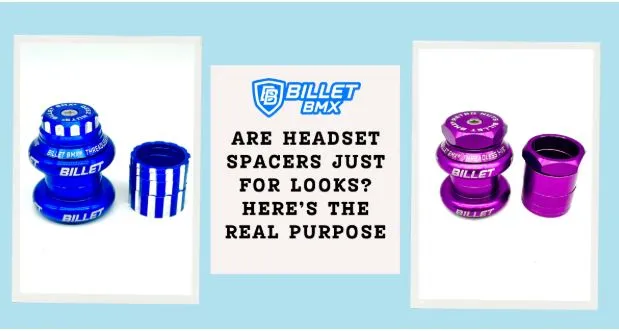Are Headset Spacers Just for Looks? Here’s the Real Purpose

In the world of BMX and cycling, every component of a bike serves a functional role—even the small, often overlooked headset spacers. While some may dismiss them as purely aesthetic additions, these parts actually contribute significantly to a rider’s comfort, control, and overall bike performance. In this blog, we dive deep into the real purpose of headset spacers and why they are a vital part of your BMX setup.
What Are Headset Spacers?
Headset spacers are small cylindrical rings made from materials like aluminum, carbon fiber, or steel. They are placed between the headset and the stem on a bicycle’s steerer tube. Although they may appear to be a cosmetic detail, these spacers are essential for achieving a proper fit and alignment of the handlebars.
Without headset spacers, a rider might struggle to find a comfortable and ergonomic riding position. For BMX riders, where precise control and posture are critical, the correct use of headset spacers can make a noticeable difference.
Why Do Bikes Use Headset Spacers?
The primary reason for using headset spacers is to adjust handlebar height. This adjustment directly impacts rider comfort, steering precision, and bike control. When headset spacers are used effectively, they allow for the customization of the stem’s position on the steerer tube, thus enabling a more tailored fit.
If your handlebars feel too low or your posture is causing back or wrist discomfort, adjusting your headset spacers might be the simple fix you need. By adding or removing spacers, you can fine-tune the fit of your BMX bike without replacing more expensive components.
How Headset Spacers Influence Bike Performance
Performance is key in any BMX setup, and headset spacers have a surprising role in this area. They help distribute pressure evenly across the headset, reducing long-term wear on both the fork and the head tube. This stability translates into smoother steering and better energy transfer during tricks or stunts.
In technical BMX riding or racing, even a few millimeters in handlebar height can change the dynamics of your performance. A stack of headset spacers enables you to experiment and find the optimal position that gives you the best leverage and control over your bike.
Also Read: BARANA Off-Grid Solar Kits Help Achieve Net-Zero Carbon Homes
Are Headset Spacers Just for Looks?
This question often comes up in bike forums and among new riders. The answer is: no, headset spacers are not just for looks. While some riders use custom-colored spacers to match their bike’s aesthetic, the core purpose remains functional. A flashy spacer might add to your bike’s visual appeal, but its real job is to provide adjustment flexibility and ensure mechanical integrity.
At Billet BMX, our headset spacers not only look great but are precision-engineered for high performance and long-lasting durability. Whether you’re aiming for a cleaner design or enhanced ergonomics, there’s a spacer that fits your needs.
Types of Headset Spacers and Materials
The most common types of headset spacers are made from:
- Aluminum: Lightweight and durable, aluminum spacers are the standard for most BMX riders.
- Carbon Fiber: Preferred for high-end builds due to its lightweight and sleek finish.
- Steel: Strong but heavier; used when maximum durability is needed.
- Plastic: Rarely used in performance builds, mostly for temporary setups or budget bikes.
Each material has its own pros and cons, but all serve the same essential function adjusting the stem height and protecting the headset system.
How Many Headset Spacers Should You Use?
There’s no one-size-fits-all answer to this question. The number and thickness of spacers you need depend on your body size, riding style, and BMX handlebar preferences. Most riders use between one to three spacers, typically ranging from 5mm to 20mm in combined height.
The key is to experiment. Try different spacer configurations to see what feels best for your posture and performance needs. Keep in mind that adding too many spacers can affect bike geometry, while too few may cause strain or discomfort.
Installing Headset Spacers: A Quick Guide
Installing headset spacers is a straightforward process if you have the right tools:
- Remove the stem bolts and slide the stem off the steerer tube.
- Add or remove spacers as needed.
- Place the stem back on, ensuring it sits flush on the spacers.
- Tighten the top cap gently until there’s no play in the headset.
- Align the handlebars and re-tighten the stem bolts.
Always make sure the top cap compresses the entire stack properly to avoid any looseness or damage to your headset.
When Should You Replace Your Headset Spacers?
Though headset spacers are not typically subject to rapid wear, they should be inspected periodically. Replace them if you notice any of the following:
- Cracks or signs of stress
- Warping or misalignment
- Corrosion, especially on aluminum or steel spacers
- Poor fit or wobble
At Billet BMX, you’ll find high-quality headset spacers that are built to last, ensuring both safety and style for your BMX setup.
Where to Find the Best Headset Spacers?
Finding the right spacer isn’t just about size—it’s also about quality and compatibility. At Billet BMX, we offer a wide selection of headset spacers that meet the needs of beginner and professional BMX riders alike. Our spacers are designed for durability, precision, and performance, all while offering sleek visual options to match your style.
Whether you’re upgrading your entire cockpit or fine-tuning your ride height, Billet BMX has the perfect headset spacers to complete your build.
Final Thoughts on Headset Spacers
To sum it up, headset spacers play a critical role in rider comfort, bike handling, and performance. While they may enhance the appearance of your BMX, their primary function is deeply rooted in mechanical necessity. Don’t overlook this small but essential component when building or upgrading your bike.






